The book is real! To celebrate, I will give out five copies to interested early career folks. DM if you’d like one.
08.11.2025 02:04 — 👍 82 🔁 22 💬 8 📌 4@talimendelberg.bsky.social
@talimendelberg.bsky.social
The book is real! To celebrate, I will give out five copies to interested early career folks. DM if you’d like one.
08.11.2025 02:04 — 👍 82 🔁 22 💬 8 📌 4
Enjoyed discussing rural politics & the place-based divide w/ @mikealbertus.bsky.social! open.substack.com/pub/michaela...
05.12.2025 13:55 — 👍 10 🔁 5 💬 1 📌 0New from me (with @talimendelberg.bsky.social): are concerns about 'neighborhood context' real? (spoiler: yes, very much) Do people prefer traditional/brick buildings? (spoiler: no). And does changing style to "fit" boost support? (spoiler: only a tiny bit). doi.org/10.1177/1078....
26.11.2025 21:05 — 👍 10 🔁 4 💬 1 📌 1
The Boomers Are Protesting Trump. Where Is Gen Z? www.nytimes.com/2025/11/24/o...
25.11.2025 01:05 — 👍 2 🔁 1 💬 0 📌 0Excellent article on an important topic
www.cambridge.org/core/journal...
Applications due October 20th.
08.09.2025 15:16 — 👍 1 🔁 1 💬 0 📌 0
Delighted this book won the APSA South Asia Frankle Prize, and proud it’s published in our Princeton Behavior Series! Migrants and Machine Politics | Princeton University Press press.princeton.edu/books/hardco...
10.09.2025 13:31 — 👍 1 🔁 0 💬 0 📌 0Happy to see our article published! "Race, Voice, and Authority in Discussion Groups" with @elizabethelder.bsky.social, @profkarpo.bsky.social,and David Ribar
09.09.2025 19:48 — 👍 2 🔁 0 💬 0 📌 0
https://puwebp.princeton.edu/AcadHire/apply/index.xhtml;jsessionid=2OEppk7LukLedBLTNM5r0N7lJWQ_iWSupk4IpPe1joOyRCOgRQkw!-1632854922
puwebp.princeton.edu/AcadHire/app...
08.09.2025 14:07 — 👍 2 🔁 3 💬 1 📌 0pleased to have had the opportunity to collaborate on this!
08.09.2025 12:31 — 👍 1 🔁 0 💬 0 📌 0please apply to our Princeton CSDP fellowships! Due *October 20th*
Post-Doctoral Associate:
puwebp.princeton.edu/AcadHire/app...
Visiting Scholar:
www.princeton.edu/acad-positio...

Princeton's SPIA highlights the work of Professor Tali Mendelberg @talimendelberg.bsky.social and Claire Willeck looking at college age voter participation.
spia.princeton.edu/news/researc...
Imagine if they’d had sandwiches. 🥪
15.08.2025 17:37 — 👍 40315 🔁 12209 💬 1166 📌 684My article with Claire Willeck about how colleges can help students turn out to vote just published in @polbehavior.bsky.social nam12.safelinks.protection.outlook.com?url=https%3A...
22.07.2025 18:02 — 👍 4 🔁 1 💬 0 📌 0Nearly half of Trump’s 2020 campaign money came from non-wealthy donors, yet GOP’s Big Beautiful Bill cuts health benefits for ~11.8 million while preserving tax breaks for the rich.
Question now: Can Trump’s “plutopopulist” coalition hold? cup.org/4cfm0Az
Grok, what is crony capitalism?
05.06.2025 19:00 — 👍 461 🔁 114 💬 10 📌 2I'm just glad one of these men has the nuclear codes and the other has all our personal data.
05.06.2025 20:24 — 👍 67194 🔁 14721 💬 1620 📌 876Democracy thrives on equality.
Equality requires inclusion.🏳️🌈
Our democracy is strongest when everyone can participate fully and authentically. Happy Pride to all who make our communities more vibrant and our democracy more complete.
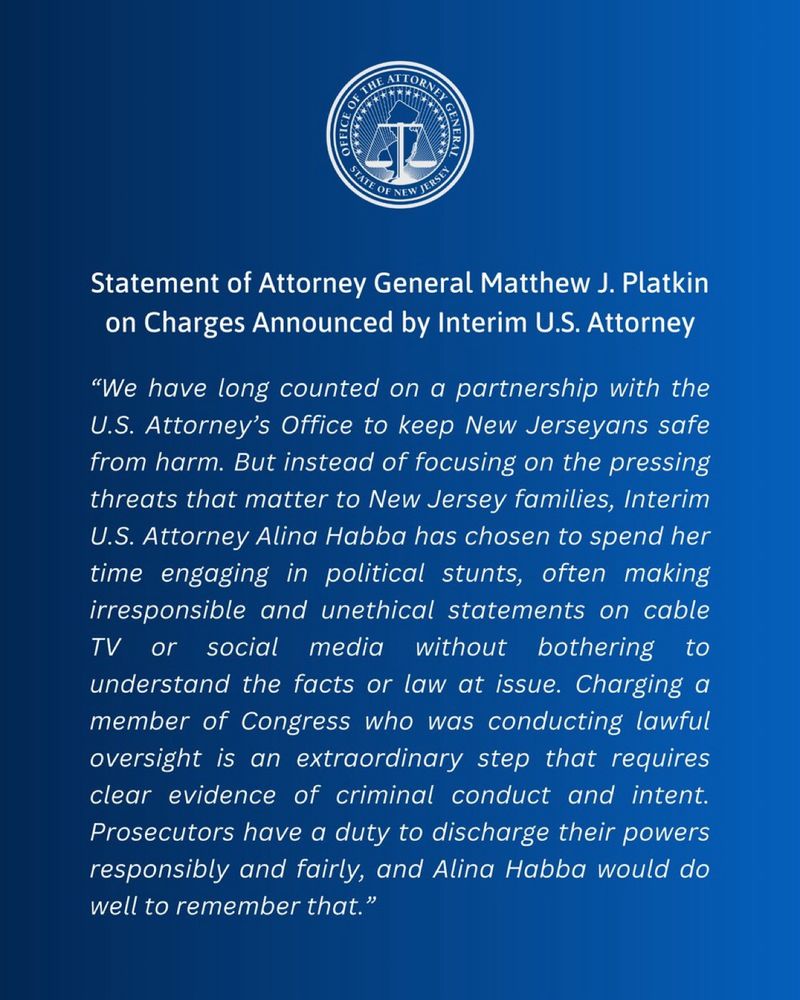
Statement from the NJAG Matt Platkin
20.05.2025 04:30 — 👍 12914 🔁 4089 💬 374 📌 197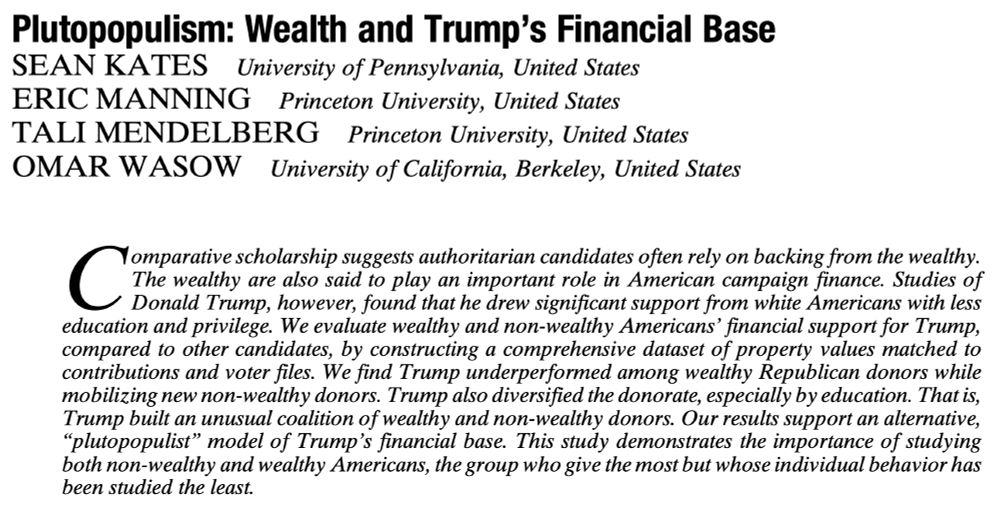
Plutopopulism: Wealth and Trump’s Financial Base SEAN KATES, ERIC MANNING, TALI MENDELBERG and OMAR WASOW Comparative scholarship suggests authoritarian candidates often rely on backing from the wealthy. The wealthy are also said to play an important role in American campaign finance. Studies of Donald Trump, however, found that he drew significant support from white Americans with less education and privilege. We evaluate wealthy and non-wealthy Americans’ financial support for Trump, compared to other candidates, by constructing a comprehensive dataset of property values matched to contributions and voter files. We find Trump underperformed among wealthy Republican donors while mobilizing new non-wealthy donors. Trump also diversified the donorate, especially by education. That is, Trump built an unusual coalition of wealthy and non-wealthy donors. Our results support an alternative, “plutopopulist” model of Trump’s financial base.
The GOP’s identity crisis over Trump’s “big, beautiful bill” exposes a core tension in today’s Republican Party: a “plutopopulist” coalition where wealthy donor interests clash with the party’s increasingly non-wealthy voter base. 🧵 1/ cup.org/4cfm0Az
17.05.2025 21:08 — 👍 59 🔁 20 💬 5 📌 5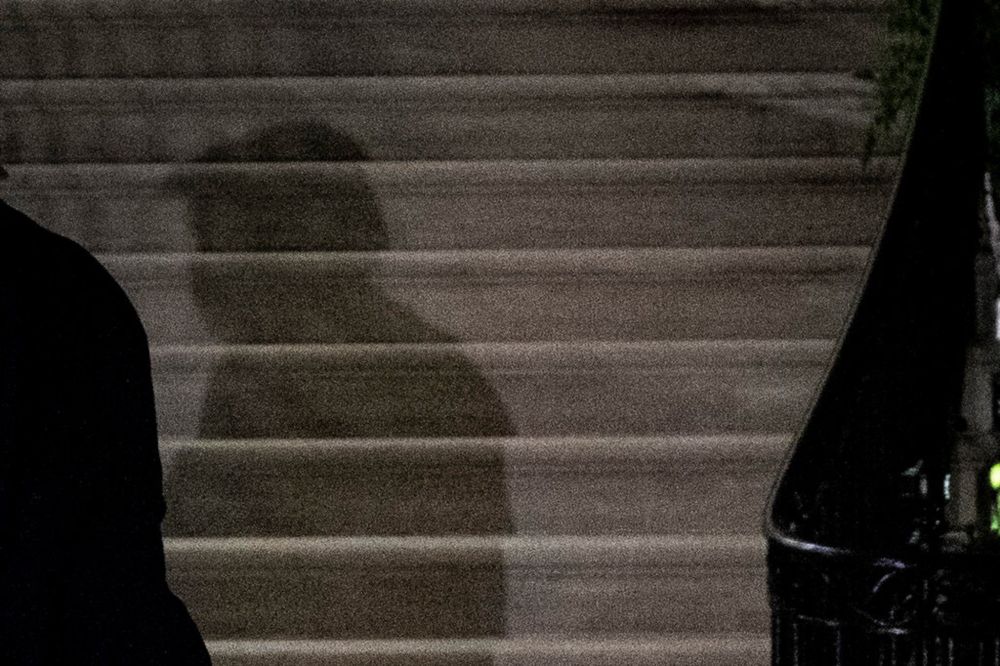
"It’s futile to predict specifically what Trump would do. Unpredictability is one of his characteristics." Professor Tali Mendelberg quoted in @nytimes.com guest essay @talimendelberg.bsky.social
www.nytimes.com/2025/04/29/o...
Co-authors on “Plutopopulism: Wealth and Trump’s Financial Base” are Sean Kates, Eric Manning and @talimendelberg.bsky.social . cup.org/4cfm0Az
17.05.2025 21:18 — 👍 10 🔁 2 💬 1 📌 0
🚨 Urge your senators and house representatives to support for FY 2026 Science Funding! Send a quick note to your House Representatives and Senators urging them to sign each of the Dear Colleague Letters.
Learn more at the COSSA Action Center: buff.ly/bHQ66dc #WhySocialScience
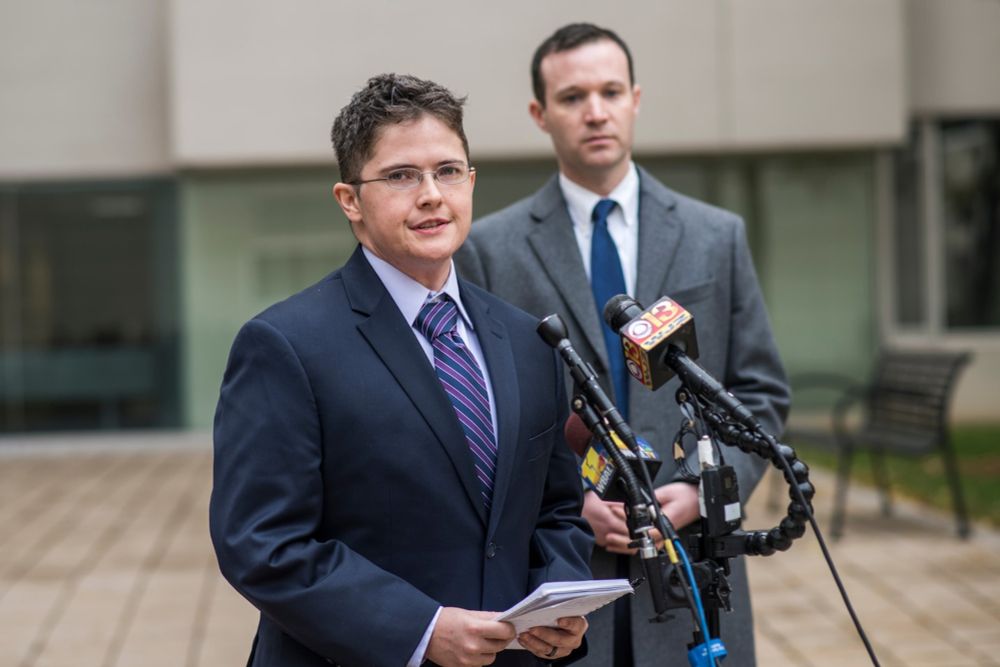
This is a shameful decision that hurts national security, flies in the face of DoD's own decade-long experience with transgender soldiers who have served honorably, and is flatly unconstitutional. What a disgrace.
06.05.2025 21:45 — 👍 323 🔁 92 💬 11 📌 3Warnock: Don’t lecture to me about meritocracy while I witness you nominate the most unfit unqualified people we’ve ever seen.
You cannot lecture me about merit while nominating Pete Hegseth…
Fascinating.
04.05.2025 18:34 — 👍 10 🔁 6 💬 1 📌 0For a longer, more detailed overview of the Plutopopulism paper, see: bsky.app/profile/owas...
04.05.2025 17:21 — 👍 8 🔁 2 💬 0 📌 0The oligarchy debate isn’t either/or. Our data reveal that candidates like Trump in 2020 (and Obama in 2012) are able to build unusual “plutopopulist” coalitions combining reduced (yet substantial) elite support with massive non-wealthy mobilization. cup.org/4cfm0Az
04.05.2025 16:31 — 👍 22 🔁 5 💬 1 📌 0
Figure 3 in paper. Bar charts showing Percent Change in Fundraising between Romney in 2012 and Trump in 2016 and 2020, by Wealth Rank. In 2016, Trump lost 73% of Romney’s dollars from the top 1%, but lost only 55% of Romney’s dollars from the bottom 90%. In 2020, Trump recovered among the wealthy: the top 1% contributed similar totals to Trump and Romney, and the top 0.1% gave Trump 16% more than Romney. However, the most striking result from 2020 is Trump’s increased fundraising from the non-wealthy. The bottom 90% gave him 172% more than Romney. These findings reveal that Trump’s financing depended much less on the wealthy than did Romney’s. To be sure, Trump fully recovered wealthy dollars in 2020. But he more than recovered non-wealthy dollars. Trump’s non-wealthy dollars and shares are dramatically larger than Romney’s (and the largest in the figure). Open access link to paper: http://cup.org/4cfm0Az
In 2020, Trump’s support surged among non-wealthy donors. Compared to Romney, Trump’s support among bottom 90% grew 172%, while top 1% was basically flat. 4/ cup.org/4cfm0Az
04.05.2025 16:31 — 👍 17 🔁 3 💬 1 📌 0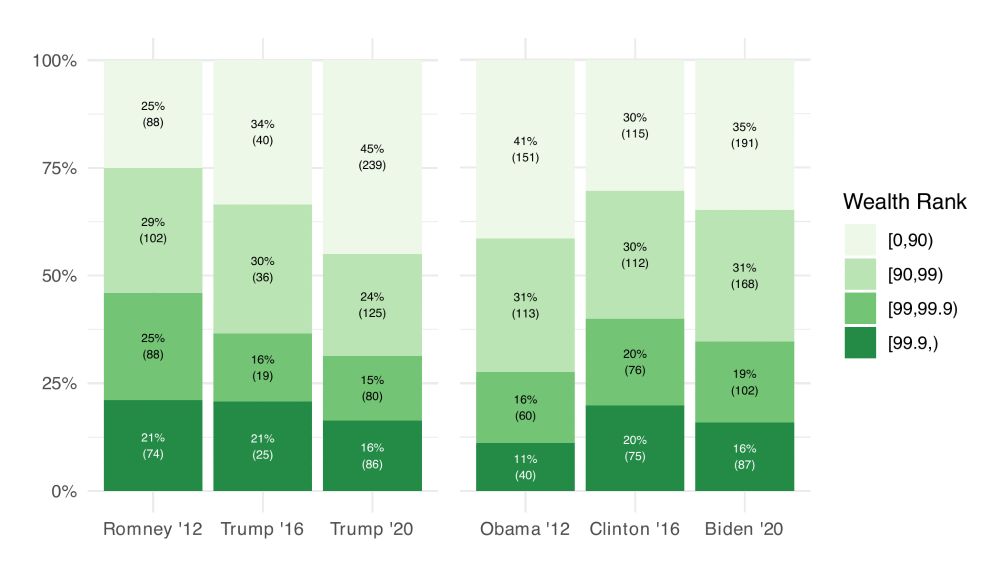
Figure 2 in paper presents the proportion of a campaign’s itemized total from each wealth group in stacked bar charts. Each bar represents a candidate-year, with segments showing the percentage of total dollars that come from each of four wealth bins. In both 2016 and 2020, Trump was much less reliant on the wealthy than Romney. Compared to Romney, Trump’s share of dollars from the bottom 90% is 9 percentage points higher in 2016, and 20 percentage points higher in 2020. In dollar terms, Trump got 2.7 times more dollars than Romney from the bottom 90% (in 2020). Likewise, Trump’s share from the top 1% (the sum of the top two bins) is 9 and 15 percentage points lower than Romney’s. To be sure, most of Trump’s dollars still came from the wealthy. Even in 2020, the wealthiest 10% gave him 55% of his dollars. However, the bottom 90% nearly matched them. To put this in sharp relief, the candidate with a wealth distribution of dollars closest to Trump’s in 2020 is Obama.
In terms of donors, Trump complicates the oligarchy story. While most of his 2020 funding (55%) came from the top 10%, that’s the lowest reliance on wealthy of any candidate we studied. Nearly 45% of 2020 donations came from bottom 90%—a remarkable shift for a Republican. 3/ cup.org/4cfm0Az
04.05.2025 16:31 — 👍 31 🔁 7 💬 2 📌 2